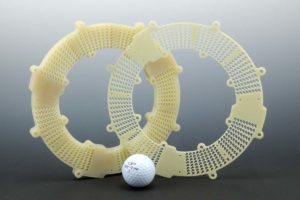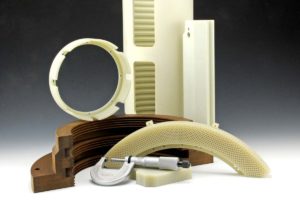Composite Machining
Mica-Tron Products Corp. has been machining composites since it opened its doors in 1959. Over the decades, we have had the opportunity to machine a wide variety of grades of commercially available composite materials, including special grades which composite manufacturers develop on a “proprietary” basis, specifically for our customers’ applications. Our knowledge gained by machining this vast array of composite materials has established Mica-Tron Products Corp. as one of the leaders in composite machining.
Due to our extensive experience, we are able to develop a process plan to machine your components, a plan that minimizes the necessity for “in-process” adjustments, an effective plan that saves you money by reducing wasted hours of labor. We not only select the proper tools, design the most effective fixtures, and use the most efficient machining processes, we also design and build (onsite) all fixtures that are needed to machine your parts, reducing lead times considerably.
Available in our facility, an extensive selection of machines and tooling allows us to keep all machining operations in-house, a key factor to our success in providing you with top quality. Our equipment includes: custom-built diamond wheel saws; Blanchard, surface, cylindrical, and centerless grinding machines; manual and CNC turning; manual and CNC milling. Our facility was carefully designed and is fully equipped to process non-metallics, including the wide variety of today’s newer composite materials.
Mica-Tron Products Corp. routinely machines all grades of composite materials ranging from the well-known, moderately priced, high-pressure laminates like NEMA Grades G-10, G-7, or G-9, to the extremely costly polyimides, polyamide-imides and polybenzimidazole, (Vespel ®, Torlon ®, and Celazole®).
Finally, our quality system (recognized and certified to ISO 9001:2015 and AS9100D) gives you the assurance that you are getting the materials and finished components you expect.
Composites
Composites are materials that are comprised of a minimum of two materials, one being a strong load-carrying material, known as the reinforcement, imbedded in a weaker material, known as the matrix. The reinforcement provides strength and rigidity while the matrix maintains the position and orientation of the reinforce-ment. The matrix can also protect the reinforcement from degradation and provide shape or form to the component.
Composites include well-known materials such as concrete (gravel as the reinforcement, cement as the matrix), plaster casts (bandage material as the reinforcement, plaster as the matrix), and fiberglass bathtubs (fiberglass strands as the reinforcement, plastic resin as the matrix).
For our purposes, the term composites is used to describe products made from a variety of reinforcement materials imbedded in thermosetting or thermoplastic resins.
These types of composites can be classified into roughly three or four types according to the filler types:
- Particulate
- Short Fiber
- Long Fiber
- Laminate
Particulate composites are materials in which the reinforcement materials are roughly round in shape. Examples of particulate fillers are: glass beads, glass powder, and ceramic or mineral powders.
Short fiber and also long fiber composites are composites in which the reinforce-ment material has a length to diameter ratio, l/d, greater than one. Short fiber composites are generally taken to have l/d of < 100, whereas long fiber composites generally have l/d > 100.
Laminate composites are the type of composites that use reinforcement material in the form of sheets rather than round particles or fibers.
The most common types of matrices are thermosetting resins (require curing agents). These are a class of resins that chemically react under specific time and temperature conditions. As soon as this reaction takes place, the material becomes fused into a solid state and will not melt with the application of heat. Epoxy resins are the most widely used thermosetting resins in the composites field. Other resins include phenolic, polyester, vinylester, melamine, silicone and polyimide.
Thermoplastic resins (no curing agent) may also be used as matrices of composite materials. Thermoplastics are resins which soften when heated but they harden again when cooled. Examples of thermoplastic matrices are PEEK, PVC, ABS, PPE, and PPS.
The most commonly recognized group of composite materials are the high- pressure thermoset laminate composites.
These composites are available with a wide variety of reinforcements and thermosetting resins, such as:
- Paper Based Laminates (NEMA Grades X, XP, XX, XXX, FR-1)
Paper based phenolics are the most economical of the laminates, yet they provide significant electrical properties and good mechanical properties. - Cotton Fabric Based Laminates (NEMA Grades C, CE, L, LE)
Cotton fabric phenolics offer greater strength than that offered by paper reinforced grades. Canvas grades are often used for structural and mechanical applications. When smaller, more intricate shapes are required, fine weave cotton fabric (commonly called linen) offers better machining characteristics than those offered by canvas. - Glass Fabric Based Laminates (NEMA Grades G-10, FR-4, G-5/G-9, G-11)
Glass based grades have better dimensional stability, better mechanical strength, and lower moisture absorption, as compared to paper or cotton reinforced composites. However, due to the glass content and resin type, glass based grades are more difficult to machine, compared to paper or cotton based grades. - Synthetic Fabric Grades (Kevlar® aramid fiber & Carbon Fiber Fabrics)
When embedded in certain resins, aramid and carbon fiber fabrics offer impressive properties: They excel in heat resistance and in mechanical strength; also, in the case of aramides, they have excellent electrical properties.
Regardless of the grade of composite that may be required for your component needs, rest assured that Mica-Tron Products Corp. has the knowledge and experience to machine your components in the most efficient, most cost effective manner, and we offer unsurpassed quality.



